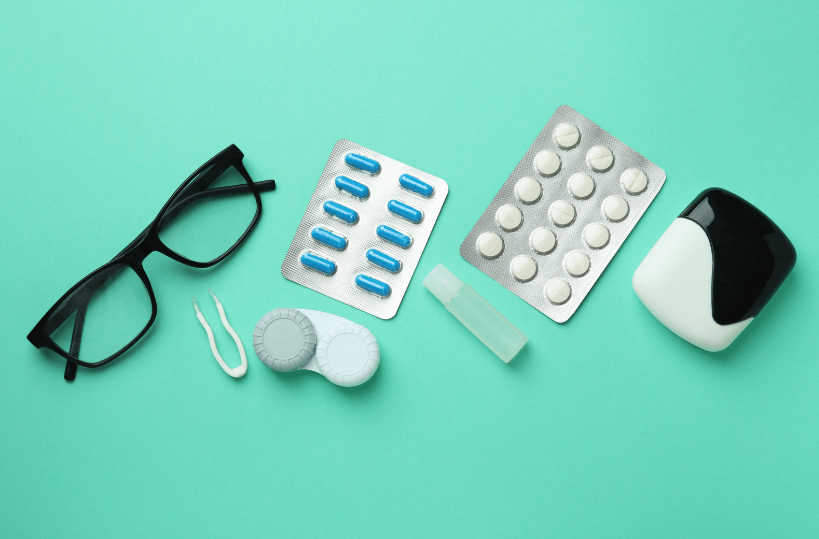The modern lifestyle negatively affects eye health. Constant screen use, staying up late, and artificial lights all place a strong burden on optimal eye functioning. This way, people do not provide their eyes with an opportunity to change the eye focus regularly, which results in an imbalance of the tone of muscles that move the eye, leading to eye strains, dry eye syndrome, and inflammatory processes. Things can get even worse when the diet is not keeping up with the nutrient requirements for proper vision.
Optimal functioning of eye structures requires sufficient daily nutrient intake, which should ideally be coming from a nutrient-dense diet. While supplementation is not a replacement for a healthy diet rich in vitamins, minerals, and antioxidants, it can significantly improve eye health speed up positive changes to your vision, or sometimes even reverse certain symptoms.
This ultimate supplement protocol for eye health & vision includes science-backed ingredients that nourish eye structures. The nutrients include vitamin A, vitamin E, vitamin C, lutein & zeaxanthin, astaxanthin, zinc, saffron, selenium, bilberry, and omega-3 fatty acids. They work in several different ways: fight oxidative stress and increase antioxidant capacity, improve vascular health, and provide nutrition for eye structure and function. Moreover, they are especially effective for eye health due to their naturally high concentrations within eye structures.
Vitamin A
Vitamin A is crucial for maintaining a healthy outside covering of the eye called cornea. Vitamin A activates a photopigment called rhodopsin, which is required for vision in low light conditions. Vitamin A deficiency usually leads to dry eyes and poor night vision that could even lead to night blindness. A small study has found that vitamin A supplementation can improve the quality of tears, thus aiding dry eye symptoms.
Vitamin E
Eye issues are usually thought to be the result of significant oxidative stress, a condition when the antioxidant system of the body is not enough to fight harmful free radicals. Vitamin E is one of the most potent antioxidants in the body, helping protect eye cells from oxidative damage. Studies have found that high dietary intake of vitamin E as well as additional supplementation of vitamin E along with other nutrients can significantly lower the risk of age-related macular degeneration, which is relatively common in older people. (1, 2)
Vitamin C
Vitamin C is well-known for its antioxidant function, making it a perfect match with vitamin E to fight oxidative stress and improve eye health. A high dietary intake of vitamin C may be helpful for preventing age-related eye disorders and supporting overall eye health. Vitamin C is also required for the production of collagen, which is a crucial component for some eye structures, such as cornea and sclera. According to one study, a daily vitamin C intake of over 500 mg could potentially reduce the risk of cataracts by 75%.
Lutein & Zeaxanthin
Lutein and zeaxanthin are plant compounds known as carotenoids. Both lutein and zeaxanthin are found in the eye structures called macula and retina, where they play a protective role by acting as antioxidants and filtering out blue light. Modern studies support the notion that these carotenoids can help with preventing or improving age-related eye disorders, like macular degeneration and cataracts. (1, 2) Although a diet rich in fruits and vegetables provides a considerable amount of lutein, additional supplementation with higher dosages may help people with cataracts improve vision.
Astaxanthin
Unlike the plant-derived lutein and zeaxanthin, the carotenoid astaxanthin mainly comes from seafood, such as krill and salmon. Astaxanthin acts as an antioxidant, potentially decreasing damage to cell membrane and DNA by reducing biomarkers of lipid peroxidation, hence lower oxidative stress.. Astaxanthin is often used for its photoprotection properties. Together with lutein and zeaxanthin, astaxanthin may help prevent visual impairment caused by overuse of digital screens.
Zinc
Zinc is an essential mineral supporting hundreds of biochemical reactions in the body. Zinc is also vital for eye health as it’s highly concentrated in the retina and the vascular layer called choroid. Zinc also plays a role in the transport of vitamin A from the liver to the eye. Zinc deficiency negatively affects eye structure, while higher zinc intake may protect against poor night vision, cataracts, and age-related macular degeneration.
Selenium
Selenium is also an essential trace mineral primarily touted for its antioxidant function. In the body, selenium acts as a part of major antioxidant enzymes such as glutathione. Thanks to its high concentration in the macula, selenium protects the cells of the macula from oxidative damage, thus acting together with zinc and other antioxidants to prevent vision impairment.
Saffron
Saffron is a plant compound and a strong antioxidant. In addition to fighting oxidative stress, which helps improve the integrity of eye structures, saffron can also help relieve hypertension in the eye, potentially preventing the development or progression of glaucoma. Indeed, saffron supplementation improves the function of the retina and slows down the progression of macular degeneration. Saffron supplementation also improves vision quality, particularly color perception and contrast.
Omega-3 fatty acids
Omega-3 fatty acids are polyunsaturated fats with a wide range of health benefits. EPA and DHA are two main omega-3 fatty acids, and DHA is highly concentrated in the cell membrane of the cells of the retina. Omega-3 fats are crucial for the integrity of cell membranes because a sufficient quantity of DHA helps alleviate inflammation. Overall, scientific studies also support the potentially protective role of higher intake of omega-3 fatty acids against the development and progression of age-related visual disturbances such as macular degeneration and cataracts. Therefore, omega-3 fatty acids are crucial for reducing eye damage caused by factors such as unnatural light, inflammation, age-related changes, and oxidative stress.
Bilberry
People have used bilberry for centuries, both as medicine and food. Bilberry fruit contains high amounts of anthocyanins, plant pigments with a strong antioxidant activity. In the body, anthocyanins are capable of neutralizing harmful free radicals, which are thought to be responsible for many chronic health conditions, including eye disorders. A few studies found that supplementing a combination of bilberry and DHA helps reduce symptoms of dry eye by reducing oxidative damage and improving tear production. (1, 2) Bilberries are frequently used for vascular complications, especially in case of diabetes. This makes bilberries especially useful for preventing or delaying the onset of diabetic retinopathy. In addition to benefiting eye health directly, bilberries can also lower blood glucose levels and support healthier metabolism, which reduces the damaging effects of high blood sugar on the retina. Bilberries may also be helpful for other eye-related issues, including macular degeneration, cataracts, and myopia.
Conclusion
A healthy, nutrient-dense diet is crucial not only for overall health but also for healthy eye structure and vision. There are certain vitamins, minerals, and other nutrients that are highly concentrated in eye structures, including vitamins A, C, and E, selenium, zinc, lutein, and omega-3 fatty acids. Antioxidants such as astaxanthin, saffron, and bilberry extract can also provide strong support and even help prevent or improve some eye disorders.
Supplementation has its own benefits and risks, especially if you have any medical condition and take prescription medications. We strongly recommend you consult your doctor before supplementing with any nutrients to avoid negative interactions and consequences.



